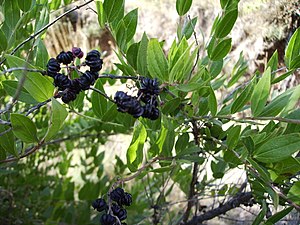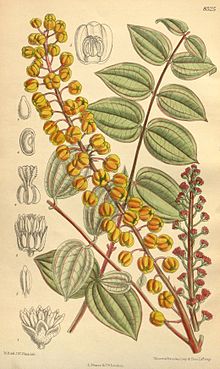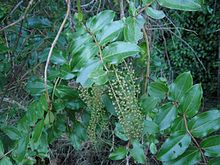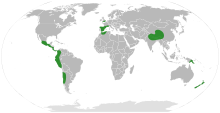Tannins
| Tannins | ||||||||||||
|---|---|---|---|---|---|---|---|---|---|---|---|---|

Myrtle-leaved Gerberstrauch ( Coriaria myrtifolia ), branches with leaves and the very poisonous fruits |
||||||||||||
| Systematics | ||||||||||||
|
||||||||||||
| Scientific name of the family | ||||||||||||
| Coriariaceae | ||||||||||||
| DC. | ||||||||||||
| Scientific name of the genus | ||||||||||||
| Coriaria | ||||||||||||
| L. |
The tanner bushes ( Coriaria ) are the only genus of the plant family of the tanner bush plants (Coriariaceae) within the order of the pumpkin-like (Cucurbitales). The 16 or so species occur in a strongly disjointed area . The botanical name Coriaria is derived from the Latin word corium for fur, skin, leather and refers - like the German name Gerberstrauch - to the utilization of some species for tannery .
description

Vegetative characteristics
Coriaria species are shrubs , rarely sub-shrubs or trees , which can be evergreen or deciduous. All parts of the plant are poisonous, especially the leaves and fruits. Many branches look like compound leaves. The opposite or in whorls arranged leaves are sessile, simple, leathery and entire. Small stipules are present.
Generative characteristics
The flowers are solitary or in racemose inflorescences . They have unisexual or hermaphrodite flowers on one specimen. The radially symmetrical , small flowers are five-fold (six-fold?) With a double flower envelope (perianth). There are five sepals each. The five fleshy petals are smaller than the sepals. There are two circles with five fertile stamens each , which are not fused together. The anthers tower over the petals. The five (to ten) upper carpels are not fused or only at the base. There is only one hanging, anatropic ovule per carpel . The five styluses each end in a curved back scar. There is at most a thin endosperm and the embryo is erect.
They form nut-like fruits, achenes , which remain covered by the enlarging petals and together form a red to black pseudostein fruit when ripe.
The basic chromosome numbers are x = 10, 15.
ingredients
The ingredients include, for example, flavonoids ( kaempferol , quercetin ), sesquiterpenes ( myricetin ) and glycosides ( coriamyrtin ).



Systematics and distribution
The generic name Coriaria was first published in 1753 by Carl von Linné in Species Plantarum , 2, p. 1037. Type species is Coriaria myrtifolia L. Synonyms for Coriaria L. are: Heterocladus Turcz. , Heterophylleia Turcz. The family name Coriariaceae was established in 1824 by Augustin-Pyrame de Candolle in Prodromus Systematis Naturalis Regni Vegetabilis , 1, p. 739.
The genus Coriaria has a very disjoint area . Gerberstrauch species have their home in the Mediterranean area , China , Himalayas , New Guinea , New Zealand , Central America and in western South America . They thrive in warm temperate areas or subtropical to tropical climates. Fossil is known to Coriaria for its 82-million-year-old pollen from Antarctica, which makes it likely that the area, which is now so disjointed, goes back to a once more continuous expansion than New Zealand, Antarctica and southern South America are physically relatively close during lower sea levels and changed continental positions were (Renner et al., 2020)
There are about 16 (5 to 30) species in the genus Coriaria or the Coriariaceae family:
- Coriaria angustissima Hook. f. : It occurs on the South Island of New Zealand and on Stewart Island.
- Coriaria arborea Linds. : The two varieties are found in New Zealand, Chatham Islands and Kermadec Islands .
- Coriaria duthiei D.K.Singh & Pusalkar : This species, first described in 2009, is distributed from Pakistan to the western Himalayas .
- Coriaria intermedia Matsumura (also referred to as a subspecies subsp. Intermedia (Matsum.) TCHuang to Coriaria japonica ): The home is Taiwan .
- Chinese Gerberstrauch ( Coriaria japonica A.Gray ): One or two subspecies occur in Japan and (if Coriaria intermedia is included ) also in Taiwan.
- Coriaria kingiana Colenso : The home is the North Island of New Zealand.
- Coriaria k Weichovensis Hu : It is widespread in south-central China.
- Coriaria lurida Kirk : It occurs in New Zealand.
- Myrtle-leaved Gerberstrauch or Redoul ( Coriaria myrtifolia L. ): It is native to Morocco, Algeria, Spain, France, the Balearic Islands, Italy and Greece.
- Chinese tanner bush ( Coriaria napalensis Wall. , Syn. Coriaria sinica Maxim. ): It is widespread from the Himalayas of Pakistan to southwest China.
- Coriaria plumosa W.RBOliv. : The home is New Zealand.
- Coriaria pottsiana W.RBOliv. : The home is the North Island of New Zealand.
- Coriaria pteridoides W.RBOliv. : The home is the North Island of New Zealand.
-
Coriaria ruscifolia L .: The two subspecies are distributed from New Guinea to the islands of the southern Pacific and from Mexico to southwest Argentina.
- Ruskus-leaved Gerberstrauch ( Coriaria ruscifolia subsp. Ruscifolia , Syn .: Coriaria sarmentosa G. Forst. ). This evergreen climbing shrub is called “Deu” or “Huique” in Chile. Rat poison is made from the fruits in southern Chile. The subspecies occurs from New Zealand to the islands of the southern Pacific and from Chile to southwest Argentina.
- Small-leaved Gerberstrauch ( Coriaria ruscifolia subsp. Microphylla (Poir.) LESkog , Syn .: Coriaria microphylla Poir. , Coriaria thymifolia Humb. & Bonpl. Ex Willd. , Coriaria papuana Warb. ): It comes from New Guinea to New Zealand and from Mexico to Peru in front.
- Coriaria × sarlurida Cockayne & Allan = Coriaria lurida × Coriaria ruscifolia : North Island of New Zealand.
- Coriaria × sarmangusta Allan = Coriaria angustissima × Coriaria ruscifolia : South Island of New Zealand.
- Coriaria terminalis Hemsl. : The distribution area extends from the central and eastern Himalayas to the Chinese province of Sichuan . There are two varieties.
In dendrograms , the Coriariaceae are the sister family of the Corynocarpaceae within the Cucurbitales .
use
The fruits of the species Coriaria terminalis and Coriaria sarmentosa are edible.
Some species are used in tannery .
swell
- Description of the family of Coriariaceae in APWebsite. (Sections Description and Systematics)
- Description of the Coriariaceae family at DELTA. (Section description)
- Abdul Ghafoor: Coriariaceae at Tropicos.org. In: Flora of Pakistan . Missouri Botanical Garden, St. Louis (Sections Description and Systematics)
- Tianlu Min, Anthony R. Brach: Coriariaceae. , P. 333 - online with the same text as the printed work , In: Wu Zheng-yi, Peter H. Raven, Deyuan Hong (ed.): Flora of China. Volume 11: Oxalidaceae through Aceraceae , Science Press and Missouri Botanical Garden Press, Beijing and St. Louis, 2008. ISBN 978-1-930723-73-3 (sections description and systematics)
- SS Renner, VD Barreda, MC Tellería, L Palazzesi, TM Schuster. Early evolution of Coriariaceae (Cucurbitales) in light of a new early Campanian (approx. 82 Mya) pollen record from Antarctica. Taxon 69 (1), 87–99, 2020 https://doi.org/10.1002/tax.12203
Individual evidence
- ^ Coriariaceae at Tropicos.org. In: IPCN Chromosome Reports . Missouri Botanical Garden, St. Louis
- ↑ Carl von Linné: Species Plantarum , 2, 1753 p. 1037 scanned at biodiversitylibrary.org .
- ↑ Augustin-Pyrame de Candolle: Prodromus systematis naturalis regni vegetabilis, sive, Enumerat ... , 1, 1824 p. 739 scanned at biodiversitylibrary.org .
- ^ Coriariaceae at Tropicos.org. Missouri Botanical Garden, St. Louis, accessed January 17, 2015.
- ^ Coriaria in the Germplasm Resources Information Network (GRIN), USDA , ARS , National Genetic Resources Program. National Germplasm Resources Laboratory, Beltsville, Maryland.
- ↑ a b c d e f g h i j k l m n o p q r s t u Rafaël Govaerts (Ed.): Coriaria. In: World Checklist of Selected Plant Families (WCSP) - The Board of Trustees of the Royal Botanic Gardens, Kew . Retrieved September 18, 2018.
- ↑ a b Entries on Coriariaceae in Plants For A Future
Web links
- Description of the family in the woods of the Andes of Ecuador. (span.)
- Coriariaceae at Tropicos.org. In: Flora of Panama (WFO) . Missouri Botanical Garden, St. Louis
